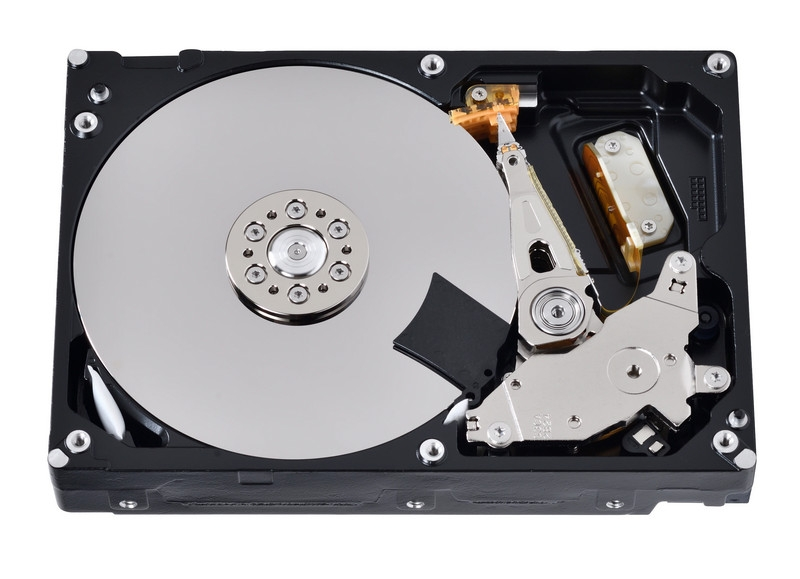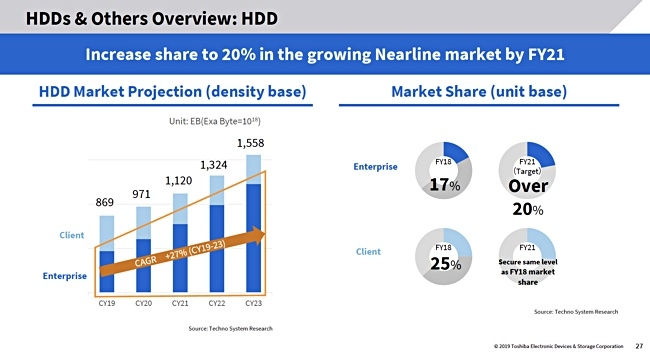
Also, the Japanese company announced its focus on the corporate segment since 2020 and plans to increase the number of 20 TB drives in enterprise solutions. Until then, Toshiba is refining its existing product lines, offering users greater reliability, buffer size and features.
So, the HDD DT02-V series for video surveillance systems, which can conditionally be attributed to the business segment, has not received significant updates compared to the previously released MD04ABA-V line , but still has some differences.
The characteristics of the new disks still feature 24/7 mode, 128 MiB cache, 600,000 cycles / 180 TB of data recording per year, simultaneous recording of 32 video streams up to 4 Mbit / s each, SATA 3.0 interface, average time between failures of 1 million hours and low power consumption.
However, in the new HDD version, the DT02-V line for DVR / NVR received an RPM of 5400 rpm instead of Low spin in the MD04ABA-V, as well as an increase in capacity of 1 TB, from 5 to 6 TB on the older model. In fact, this is a 20% increase in the working volume relative to the previous product of the company, which is extremely important for video surveillance systems.
The new Toshiba drives also support RAID up to 8 HDDs. The only serious operational limitation of the new HDDs is temperature conditions. The manufacturer claims the temperature is not higher than +40 degrees Celsius for the correct operation of the disk. Together with a design that provides low vibration, low power consumption of 3.5 watts and a large dubbing resource, the DT02-V series for DVR / NVR systems looks very attractive.
New HDDs will enter the market in stages: first, “average” 4 TB models went on sale, they are available for purchase today. In January 2020, 6 TB discs will become available, and the younger model of the DT02-V series can only be purchased in March 2020.
The new P300 consumer drives for workstations have also been expanded to 6 TB, but the changes are more significant.

First: the disk cache was increased from 64 to 128 MiB. Second: the drives are equipped with a special system for protecting against data loss upon impact, which increases the chances of HDD survival. The latter is extremely attractive precisely for the consumer segment, in which there are frequent cases of blows to the case, transfer or unskilled assembly of a PC and, accordingly, careless handling of the HDD. Also, the older model is equipped with a 7200 rpm drive (the youngest at 4 TB still works at medium speeds of 5400 rpm).
It’s a little surprising that, according to data from the Toshiba official website, it is the older P300 6 TB models that have the most efficient power consumption:

Unlike its “corporate” counterparts in the DT02-V series, P300 drives are less demanding in temperature conditions, which is critical for home workstations. So, the operating temperature range is designated from 0 to +65 degrees Celsius, and the storage temperature is from -40 to +70 degrees Celsius.
It is possible that in the near future we will not wait for any updates from the Toshiba for the user segment. According to the announced policy of the company ( PDF-file of the presentation), the Japanese giant will concentrate on the enterprise segment, in which it loses to its main competitors in the person of Seagate and Western Digital in terms of market share. In the consumer segment, and specifically in sales of notebook drives of the 2.5 "form factor, Toshiba is in the lead, so the company's capacities will be transferred to work with the business.

In 2019, the revenue of the entire three HDD sales companies dropped significantly due to a noticeable reduction in the cost of SSDs. However, since 2020, a significant increase in demand for corporate solutions for short-term and long-term storage and exchange of large amounts of data in data centers is expected.

This growth is associated with the active deployment of 5G networks in the United States and several other countries. Earlier, we mentioned this problem in our material on experimental fiber-optic clusters with a throughput of up to 1 Pbit / s .
Since SSDs will not be able to cover the needs of telecom operators and services in storing and transmitting data in the planned volumes, it is the HHD manufacturers that will occupy the formed niche with their high-capacity products.
That is why Toshiba is focused on increasing the share of extra-large drives by 20 TB. Now they are used in less than 10% of the company's solutions for long-term storage, but the Japanese plan to bring this figure to 50% by 2023. Toshiba also aims to expand the product line for small and medium-sized data centers, as well as for video surveillance systems. Real solutions for the last mentioned segment we can observe now.